Soil Moisture Assimilation Improves Terrestrial Biosphere Model GPP Responses to Sub-Annual Drought at Continental Scale
Abstract
1. Introduction
2. Materials and Methods
2.1. Carbon Cycle Data Assimilation System (CCDAS) and Simulation Experiments
2.2. Data
2.2.1. Meteorological Data
2.2.2. Atmospheric CO2 Concentrations
2.2.3. ESA-CCI Soil Moisture
2.2.4. GRACE-REC TWS Data
2.2.5. Top-Down Net Ecosystem CO2 Flux
2.2.6. FLUXCOM Gross Primary Productivity
2.2.7. Standardized Precipitation-Evapotranspiration Index (SPEI)
2.2.8. TRENDY GPP
2.2.9. GIMMS NDVI
2.2.10. LT_SIF
2.2.11. ENSO Indices
2.3. Statistical Analysis
2.4. Evaluation Metrics
3. Results
3.1. Soil Moisture Assimilation Performance
3.2. The Inter-Annual Variability of the Carbon and Water Fluxes
3.3. Drought Impacts on Continental GPP
4. Discussion
4.1. The Mechanism of Soil Moisture Controls on Carbon Fluxes
4.2. Legacy in the Regional GPP Variability
4.3. Drought Impacts on Continental GPP
4.4. Caveats and Implications
5. Conclusions
- 1.
- The combination of soil moisture and atmospheric CO2 concentrations in CCDAS results in a much better simulation of the terrestrial biosphere model in simulating coupled water–carbon processes in ecosystems. For NEP and GPP, the RMSE between the optimized model and Jena CarboScope as well as FLUXCOM is reduced by 6.88% and 14.93% compared to the prior experiment, and by 4.44% and 15.90% compared to only assimilating CO2. The reason why adding soil moisture observations can better represent the carbon and water cycle is that the soil moisture constrains the model’s phenology and photosynthesis through affecting the water uptake and surface energy balance-related parameters ( Tϕ, Cw0, srdepth, Sb, emis0, and Offset) and additionally controls (through these parameters) plant-available soil moisture.
- 2.
- The assimilation of soil moisture has shown the ability of improving the model’s representation of inter-annual variability of terrestrial carbon–water cycles and the atmospheric CO2 growth rate, resulting in high correlations with ENSO indices (soil moisture: >0.70, NEP: <−0.60, GPP: <−0.20, and CGR: >0.40). Soil moisture is the main factor controlling GPP at the time of ENSO events. For continents mainly distributed north of 30°N (North America, Europe, and Asia), the ENSO results in lower GPP but higher soil moisture, while for continents mainly south of 30° (South America, Africa, and Oceania), ENSO results in the same trend of GPP and soil moisture. We also found that the ENSO shows lagged effects on GPP and varies continently. North America, Asia, and Europe (mainly distributed in the Northern Hemisphere) show a >3-month time lag compared to South America, Africa, and Oceania (mainly distributed in the Southern Hemisphere), which show just a <3-month time lag.
- 3.
- We show that the optimized GPP is capable of reasonably depicting the response of GPP to sub-annual drought (≤9 months) by contrasting the continentally aggregated GPP with the comprehensive drought index SPEI. For the GPP optimized by CCDAS with both soil moisture and CO2 concentration, GPP responded to 68% of droughts detected globally with less than 9 months’ duration, while for TRENDY GPP, GIMMS NDVI, and LT_SIF, these percentages are 20%, 34%, and 23%, respectively. Based on this 9-month time scale, we analyzed the regional-scale GPP response to drought and showed that for regions at high latitude in the Northern Hemisphere, where temperature is the primary control of drought, an increase in GPP occurs with the occurrence of drought events. Similarly, for the Amazon rainforest region, where radiation is the main controlling factor, GPP is slightly enhanced when drought occurs. This indicates that using satellite-based soil moisture observations with a data assimilation approach can effectively constrain the water–carbon processes of the model and the simulation results based on this constraint can effectively reveal the response of GPP to sub-annual (≤9 months) drought at the regional scale.
Author Contributions
Funding
Data Availability Statement
Acknowledgments
Conflicts of Interest
Appendix A
| Station Name | Station Code | Latitude | Longitude | Elevation |
|---|---|---|---|---|
| Alert, NWT, Canada | ALT | 82.3°N | 62.3°W | 210 |
| Baring Head, New Zealand | BHD | 41.4°S | 174.9°E | 85 |
| Point Barrow, Alaska | BRW | 71.3°N | 156.6°W | 11 |
| Christmas Island | CHR | 2.0°N | 157.3°W | 2 |
| Cape Kumukahi, Hawaii | KUM | 19.5°N | 154.8°W | 3 |
| Mauna Loa Observatory, Hawaii | MLO | 19.5°N | 155.6°W | 3397 |
| American Samoa | SMO | 14.2°S | 170.6°W | 30 |
| South Pole | SPO | 90.0°S | 2810 |
| No. | Symbol | Description | Units | Prior | Prior unc. | Posterior |
|---|---|---|---|---|---|---|
| 1 | Maximum carboxylation rate (C3/C4) for PFT 1-13: TrEv (1; Tropical broadleaf evergreen tree), TrDec (2; Tropical broadleaf deciduous tree), TmpEv (3; Temperate broadleaf evergreen tree), TmpDec (4; Temperate deciduous tree), EvCn (5; Evergreen coniferous tree), DecCn (6; Deciduous coniferous tree), EvShr (7; Evergreen shrub), DecShr (8; Deciduous) | μmol(CO2)m-2s-1 | 6.00 × 10−5 | 1.20 × 10−5 | 7.84 × 10−6 | |
| 2 | μmol(CO2)m-2s-1 | 9.00 × 10−5 | 1.80 × 10−5 | 2.15 × 10−4 | ||
| 3 | μmol(CO2)m-2s-1 | 4.10 × 10−5 | 8.20 × 10−6 | 3.81 × 10−5 | ||
| 4 | μmol(CO2)m-2s-1 | 3.50 × 10−5 | 7.00 × 10−6 | 3.46 × 10−5 | ||
| 5 | μmol(CO2)m-2s-1 | 2.90 × 10−5 | 5.80 × 10−6 | 4.87 × 10−5 | ||
| 6 | μmol(CO2)m-2s-1 | 5.30 × 10−5 | 1.06 × 10−5 | 6.72 × 10−5 | ||
| 7 | μmol(CO2)m-2s-1 | 5.20 × 10−5 | 1.04 × 10−5 | 3.49 × 10−5 | ||
| 8 | μmol(CO2)m-2s-1 | 1.60 × 10−4 | 3.20 × 10−5 | 9.16 × 10−5 | ||
| 9 | μmol(CO2)m-2s-1 | 4.20 × 10−5 | 8.40 × 10−6 | 4.45 × 10−5 | ||
| 10 | μmol(CO2)m-2s-1 | 8.00 × 10−6 | 1.60 × 10−6 | 6.54 × 10−6 | ||
| 11 | μmol(CO2)m-2s-1 | 2.00 × 10−5 | 4.00 × 10−6 | 2.97 × 10−7 | ||
| 12 | μmol(CO2)m-2s-1 | 2.00 × 10−5 | 4.00 × 10−6 | 2.06 × 10−5 | ||
| 13 | μmol(CO2)m-2s-1 | 1.17 × 10−4 | 2.34 × 10−5 | 7.07 × 10−5 | ||
| 14 | aJ,V | Ratio Vmax to Jmax (max. electron transport rate) for PFT 1–13 | - | 1.96 | 9.80 × 10−2 | 1.81 |
| 15 | aJ,V | - | 1.99 | 9.95 × 10−2 | 1.75 | |
| 16 | aJ,V | - | 2.00 | 1.00 × 10−1 | 1.99 | |
| 17 | aJ,V | - | 2.00 | 1.00 × 10−1 | 2.07 | |
| 18 | aJ,V | - | 1.79 | 8.95 × 10−2 | 1.87 | |
| 19 | aJ,V | - | 1.79 | 8.95 × 10−2 | 1.81 | |
| 20 | aJ,V | - | 1.96 | 9.80 × 10−2 | 1.95 | |
| 21 | aJ,V | - | 1.66 | 8.30 × 10−2 | 1.66 | |
| 22 | aJ,V | - | 1.90 | 9.50 × 10−2 | 1.81 | |
| 23 | aJ,V | - | 1.40 × 10−4 | 2.80 × 10−5 | 4.47 × 10−5 | |
| 24 | aJ,V | - | 1.85 | 9.25 × 10−2 | 1.80 | |
| 25 | aJ,V | - | 1.85 | 9.25 × 10−2 | 1.84 | |
| 26 | aJ,V | - | 1.88 | 9.40 × 10−2 | 2.13 | |
| 27 | Leaf respiration ratio | - | 4.00 × 10−1 | 1.00 × 10−1 | 4.40 × 10−1 | |
| 28 | Growth respiration ratio | - | 2.00 × 10−1 | 1.00 × 10−2 | 2.48 × 10−1 | |
| 29 | Soil respiration temperature factor, fast pool | - | 1.50 | 7.50 × 10−1 | 1.67 | |
| 30 | Soil respiration temperature factor, slow pool | - | 1.50 | 7.50 × 10−1 | 1.35 | |
| 31 | Fast pool soil carbon turnover time | year | 6.60 × 10−1 | 4.00 × 10−1 | 4.25 × 10−2 | |
| 32 | Soil moisture exponential for soil respiration | - | 1.00 | 1.00 | 2.87 | |
| 33 | Fraction of fast soil decomposition | - | 2.00 × 10−1 | 2.00 × 10−1 | 2.32 × 10−1 | |
| 34 | Activation energy, dark respiration | J mol−1 | 4.50 × 104 | 2.25 × 103 | 2.56 × 104 | |
| 35 | Activation energy, carboxylation rate (C3) | J mol−1 | 5.85 × 104 | 2.93 × 103 | 6.76 × 104 | |
| 36 | Activation energy, O2 | J mol−1 | 3.59 × 104 | 1.80 × 103 | 3.58 × 104 | |
| 37 | Activation energy, CO2 | J mol−1 | 5.94 × 104 | 2.97 × 103 | 5.61 × 104 | |
| 38 | Activation energy, carboxylation rate (C4) | J mol−1 | 5.10 × 104 | 2.55 × 103 | 5.16 × 104 | |
| 39 | Photon capture efficiency (C3) | - | 2.80 × 10−1 | 1.40 × 10−2 | 2.46 × 10−1 | |
| 40 | Quantum efficiency (C4) | - | 4.00 × 10−2 | 2.00 × 10−3 | 3.45 × 10−2 | |
| 41 | Michaelis–Menten constant CO2 | μmol(CO2)mol(air)-1 °C−1 | 4.60 × 10−4 | 2.30 × 10−5 | 4.04 × 10−4 | |
| 42 | Michaelis–Menten constant O2 | μmol(CO2)mol(air)-1 °C−1 | 3.30 × 10−1 | 1.65 × 10−2 | 3.51 × 10−1 | |
| 43 | a | Temperature slope CO2 compensation point | μmol(CO2)mol(air)-1 °C−1 | 1.70 × 10−6 | 8.50 × 10−8 | 1.42 × 10−6 |
| 44 | β | Net CO2 sink/soil factor for PFT 1–13, used for adjusting soil carbon pool3 | - | 1.00 | 2.50 × 10−1 | 4.79 × 10−1 |
| 45 | β | - | 1.00 | 2.50 × 10−1 | 1.99 | |
| 46 | β | - | 1.00 | 2.50 × 10−1 | 1.01 | |
| 47 | β | - | 1.00 | 2.50 × 10−1 | 3.61 × 10−1 | |
| 48 | β | - | 1.00 | 2.50 × 10−1 | 2.28 × 10−1 | |
| 49 | β | - | 1.00 | 2.50 × 10−1 | 7.39 × 10−1 | |
| 50 | β | - | 1.00 | 2.50 × 10−1 | 1.63 | |
| 51 | β | - | 1.00 | 2.50 × 10−1 | 1.28 | |
| 52 | β | - | 1.00 | 2.50 × 10−1 | 1.59 | |
| 53 | β | - | 1.00 | 2.50 × 10−1 | 1.67 | |
| 54 | β | - | 1.00 | 2.50 × 10−1 | 6.32 × 10−1 | |
| 55 | β | - | 1.00 | 2.50 × 10−1 | 9.36 × 10−1 | |
| 56 | β | - | 1.00 | 2.50 × 10−1 | 6.55 × 10−2 | |
| 57 | Maximum leaf area index | - | 4.00 | 1.00 × 10−1 | 3.41 | |
| 58 | Phenology temperature trigger for PFT 4–6 | °C | 1.00 × 101 | 2.00 | 6.99 | |
| 59 | Phenology temperature trigger for PFT 8 | °C | 8.00 | 2.00 | 8.26 | |
| 60 | Phenology temperature trigger for PFT 9–12 | °C | 2.00 | 2.00 | -2.20 | |
| 61 | Phenology temperature trigger for PFT 13 | °C | 1.50 × 101 | 2.00 | 2.32 × 101 | |
| 62 | Spatial range of phenology temperature trigger for PFT 4–6, 8, 13 | °C | 2.00 | 1.00 | 2.06 | |
| 63 | Spatial range of phenology temperature trigger for PFT 9–12 | °C | 2.00 | 1.00 | 1.74 × 10−1 | |
| 64 | Day length at leaf shedding for PFT 4–6, 8, 11 | hour | 1.05 × 101 | 1.00 | 5.40 | |
| 65 | Spatial range of day length at leaf shedding for PFT 4–6, 8, 11 | hour | 5.00 × 10−1 | 2.50 × 10−1 | 7.78 × 10−1 | |
| 66 | Initial linear leaf growth | d−1 | 5.00 × 10−1 | 5.00 × 10−1 | 8.44 × 10−1 | |
| 67 | Inverse of leaf longevity for PFT 2, 4, 6, 8–10, 12, 13 | hour | 1.00 × 10−1 | 1.00 × 10−1 | 4.72 × 10−3 | |
| 68 | Inverse of leaf longevity for PFT 5, 11 | hour | 5.00 × 10−3 | 5.00 × 10−3 | 1.11 × 10−2 | |
| 69 | Length of dry spell before leaf shedding for PFT 1, 3, 7 | d−1 | 3.00 × 101 | 3.00 × 101 | 4.46 × 101 | |
| 70 | Length of dry spell before leaf shedding for PFT 2 | d−1 | 3.00 × 101 | 3.00 × 101 | 9.66 | |
| 71 | Length of dry spell before leaf shedding for PFT 9–10, 12, 13 | day | 3.00 × 101 | 3.00 × 101 | 8.10 | |
| 72 | Stomata internal to atmospheric CO2 (C3) | - | 6.50 × 10−1 | 6.50 × 10−2 | 5.55 × 10−1 | |
| 73 | Stomata internal to atmospheric CO2 (C4) | - | 3.70 × 10−1 | 3.70 × 10−2 | 4.47 × 10−1 | |
| 74 | Ratio of maximum water supply rate | mm d−1 | 5.00 × 10−1 | 1.50 × 10−1 | 9.56 × 10−1 | |
| 75 | emis0 | Emissivity of the atmosphere | - | 6.40 × 10−1 | 3.20 × 10−2 | 7.51 × 10−1 |
| 76 | srdepth | Rooting depth scalar for PFT 1–13 | - | 1.00 | 1.00 × 10−1 | 9.47 × 10−1 |
| 77 | srdepth | - | 1.00 | 1.00 × 10−1 | 4.59 × 10−1 | |
| 78 | srdepth | - | 1.00 | 1.00 × 10−1 | 9.91 × 10−1 | |
| 79 | srdepth | - | 1.00 | 1.00 × 10−1 | 9.77 × 10−1 | |
| 80 | srdepth | - | 1.00 | 1.00 × 10−1 | 1.12 | |
| 81 | srdepth | - | 1.00 | 1.00 × 10−1 | 9.02 × 10−1 | |
| 82 | srdepth | - | 1.00 | 1.00 × 10−1 | 1.07 | |
| 83 | srdepth | - | 1.00 | 1.00 × 10−1 | 1.20 | |
| 84 | srdepth | - | 1.00 | 1.00 × 10−1 | 6.14 × 10−1 | |
| 85 | srdepth | - | 1.00 | 1.00 × 10−1 | 4.40 × 10−1 | |
| 86 | srdepth | - | 1.00 | 1.00 × 10−1 | 1.02 | |
| 87 | srdepth | - | 1.00 | 1.00 × 10−1 | 9.90 × 10−1 | |
| 88 | srdepth | - | 1.00 | 1.00 × 10−1 | 1.47 | |
| 89 | Sb | Shape parameter retention curve scalar for soil texture 1-6: coarse (1; loam sand), medium/coarse (2; sandy loam), medium (3; loam), fine/medium (4; sandy clay loam), fine (5; clay loam), organic (6; loam) | - | 1.00 | 1.00 × 10−1 | 8.18 × 10−1 |
| 90 | Sb | - | 1.00 | 1.00 × 10−1 | 8.89 × 10−1 | |
| 91 | Sb | - | 1.00 | 1.00 × 10−1 | 1.20 | |
| 92 | Sb | - | 1.00 | 1.00 × 10−1 | 1.16 | |
| 93 | Sb | - | 1.00 | 1.00 × 10−1 | 7.19 × 10−1 | |
| 94 | Sb | - | 1.00 | 1.00 × 10−1 | 9.91 × 10−1 | |
| 95 | Sn | Soil porosity scalar for soil texture 1-6 | - | 1.00 | 1.00 × 10−1 | 1.33 |
| 96 | Sn | - | 1.00 | 1.00 × 10−1 | 3.15 × 10−1 | |
| 97 | Sn | - | 1.00 | 1.00 × 10−1 | 1.04 | |
| 98 | Sn | - | 1.00 | 1.00 × 10−1 | 6.26 × 10−1 | |
| 99 | Sn | - | 1.00 | 1.00 × 10−1 | 1.30 | |
| 100 | Sn | - | 1.00 | 1.00 × 10−1 | 9.91 × 10−1 | |
| 101 | Offset | Initial atmospheric CO2 concentration | ppm | 3.36 × 102 | 1.00 | 3.37 × 102 |
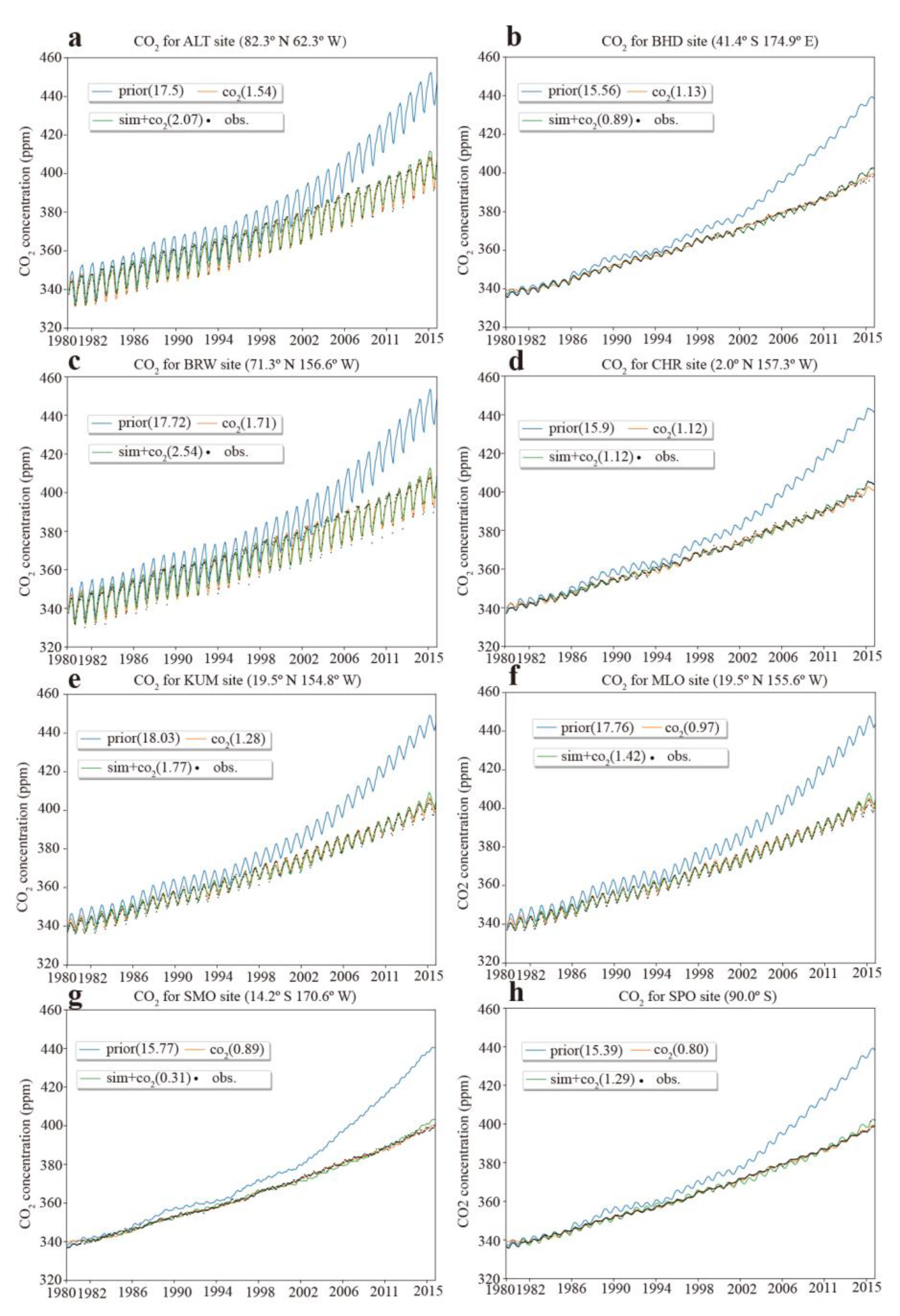

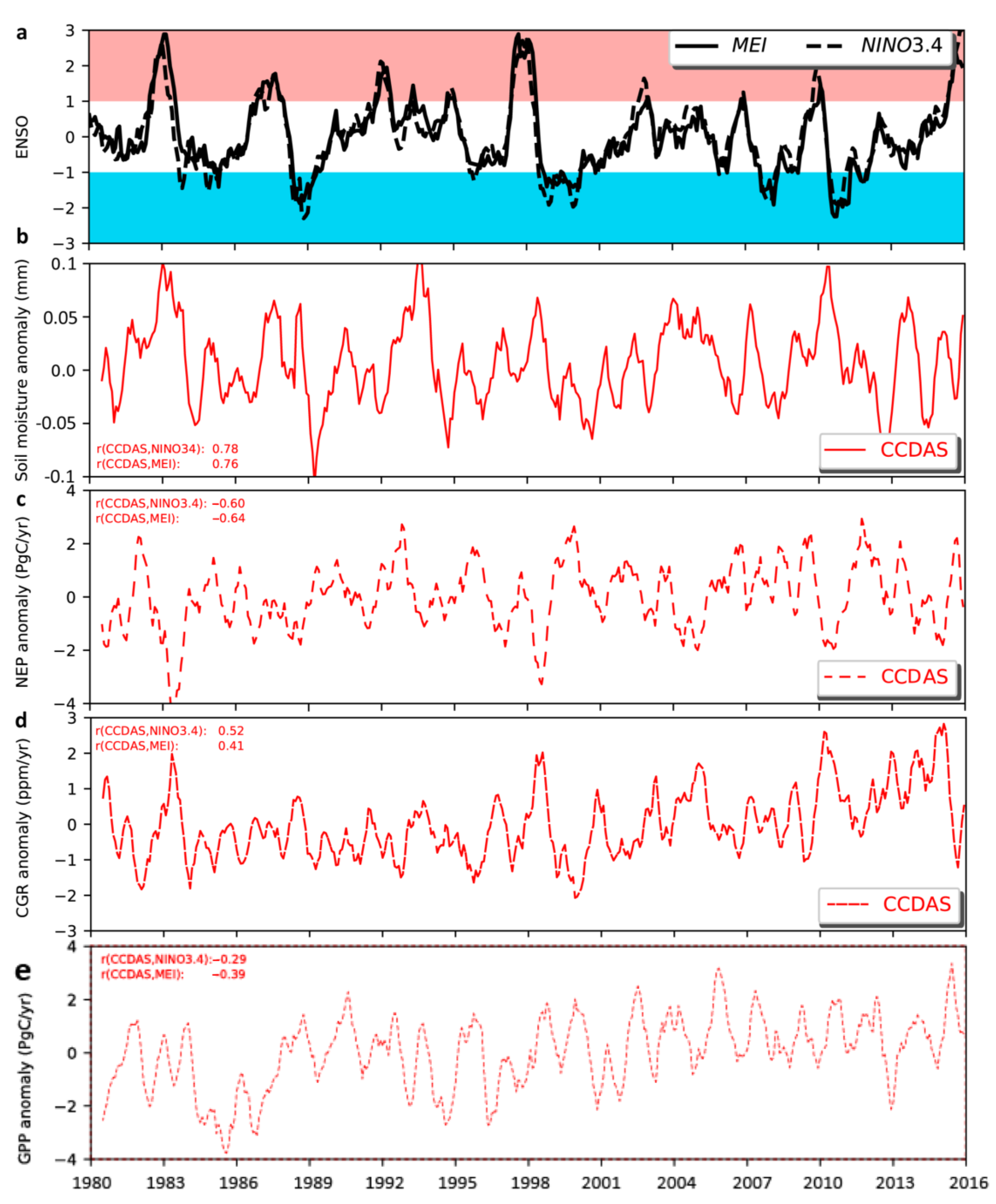



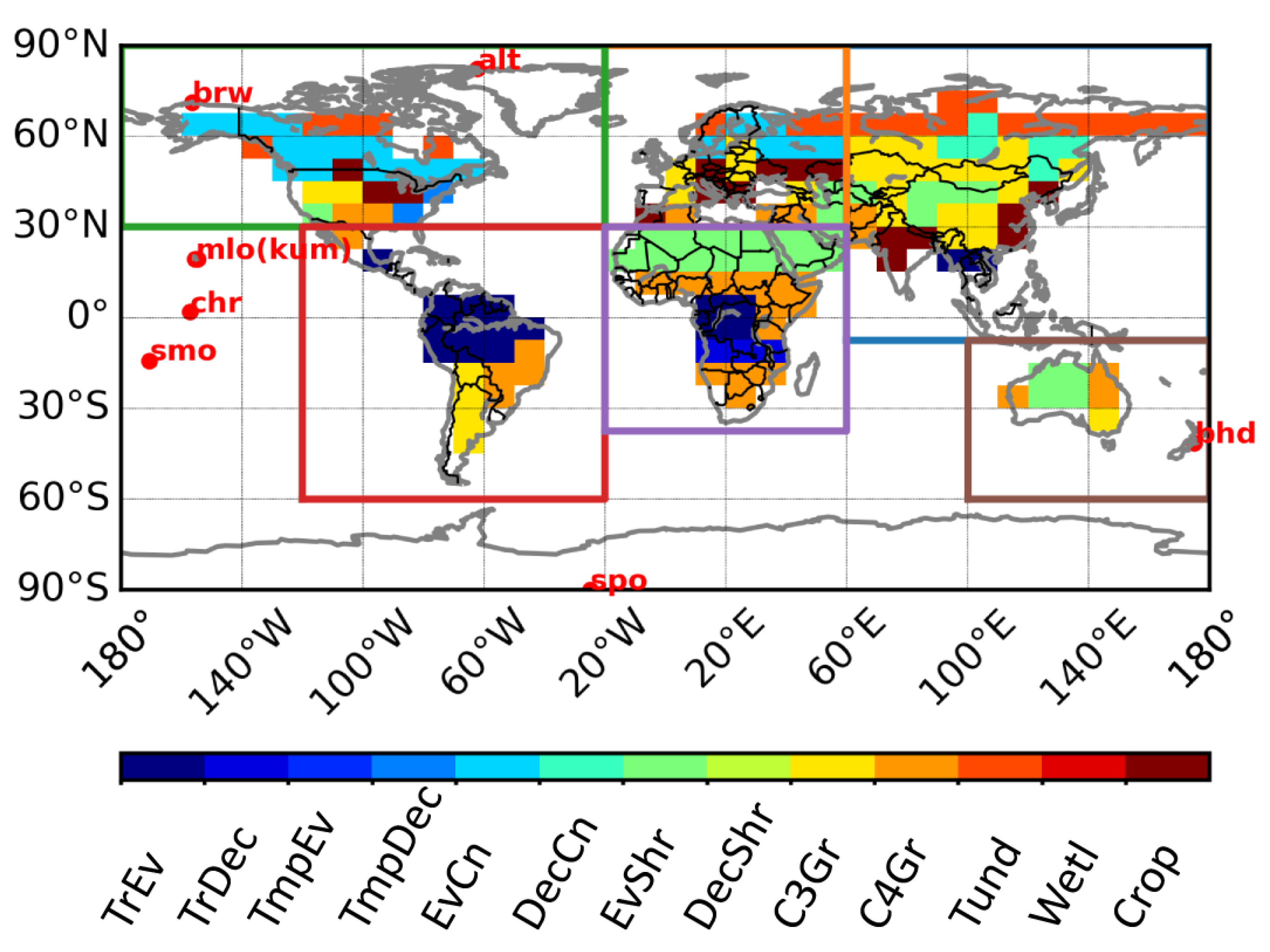

References
- Allen, C.D.; Breshears, D.D.; McDowell, N.G. On underestimation of global vulnerability to tree mortality and forest die-off from hotter drought in the Anthropocene. Ecosphere 2015, 6, 1–55. [Google Scholar] [CrossRef]
- Beer, C.; Reichstein, M.; Tomelleri, E.; Ciais, P.; Jung, M.; Carvalhais, N.; Rodenbeck, C.; Arain, M.A.; Baldocchi, D.; Bonan, G.B.; et al. Terrestrial gross carbon dioxide uptake: Global distribution and covariation with climate. Science 2010, 329, 834–838. [Google Scholar] [CrossRef] [PubMed]
- Braswell, B.H.; Schimel, D.S.; Linder, E.; Moore, B. The response of global terrestrial ecosystems to interannual temperature variability. Science 1997, 278, 870–873. [Google Scholar] [CrossRef]
- Potter, C.; Klooster, S.; Steinbach, M.; Tan, P.; Kumar, V.; Shekhar, S.; Nemani, R.; Myneni, R. Global teleconnections of climate to terrestrial carbon flux. J. Geophys. Res. 2003, 108, 4556. [Google Scholar] [CrossRef]
- Keeling, C.D.; Whorf, T.P.; Wahlen, M.; Van der Plichtt, J. Interannual extremes in the rate of rise of atmospheric carbon dioxide since 1980. Nature 1995, 375, 666–670. [Google Scholar] [CrossRef]
- Zhu, Z.; Piao, S.; Xu, Y.; Bastos, A.; Ciais, P.; Peng, S. The effects of teleconnections on carbon fluxes of global terrestrial ecosystems. Geophys. Res. Lett. 2017, 44, 3209–3218. [Google Scholar] [CrossRef]
- Wang, S.; Zhang, Y.; Ju, W.; Qiu, B.; Zhang, Z. Tracking the seasonal and inter-annual variations of global gross primary production during last four decades using satellite near-infrared reflectance data. Sci. Total Environ. 2021, 755, 142569. [Google Scholar] [CrossRef]
- Cai, W.; Yuan, W.; Liang, S.; Liu, S.; Dong, W.; Chen, Y.; Liu, D.; Zhang, H. Large Differences in Terrestrial Vegetation Production Derived from Satellite-Based Light Use Efficiency Models. Remote Sens. 2014, 6, 8945–8965. [Google Scholar] [CrossRef]
- Anav, A.; Friedlingstein, P.; Beer, C.; Ciais, P.; Harper, A.; Jones, C.; Murray-Tortarolo, G.; Papale, D.; Parazoo, N.C.; Peylin, P.; et al. Spatiotemporal patterns of terrestrial gross primary production: A review. Rev. Geophys. 2015, 53, 785–818. [Google Scholar] [CrossRef]
- Rayner, P.J.; Law, R.M. The interannual variability of the global carbon cycle. Tellus B Chem. Phys. Meteorol. 2016, 51, 210–212. [Google Scholar] [CrossRef]
- Frankenberg, C.; Fisher, J.B.; Worden, J.; Badgley, G.; Saatchi, S.S.; Lee, J.-E.; Toon, G.C.; Butz, A.; Jung, M.; Kuze, A.; et al. New global observations of the terrestrial carbon cycle from GOSAT: Patterns of plant fluorescence with gross primary productivity. Geophys. Res. Lett. 2011, 38, L17706. [Google Scholar] [CrossRef]
- Yuan, W.; Liu, S.; Yu, G.; Bonnefond, J.-M.; Chen, J.; Davis, K.; Desai, A.R.; Goldstein, A.H.; Gianelle, D.; Rossi, F.; et al. Global estimates of evapotranspiration and gross primary production based on MODIS and global meteorology data. Remote Sens. Environ. 2010, 114, 1416–1431. [Google Scholar] [CrossRef]
- Ma, N.; Niu, G.-Y.; Xia, Y.; Cai, X.; Zhang, Y.; Ma, Y.; Fang, Y. A Systematic Evaluation of Noah-MP in Simulating Land-Atmosphere Energy, Water, and Carbon Exchanges Over the Continental United States. J. Geophys. Res. Atmos. 2017, 122, 12, 245–212, 268. [Google Scholar] [CrossRef]
- Piao, S.; Sitch, S.; Ciais, P.; Friedlingstein, P.; Peylin, P.; Wang, X.; Ahlstrom, A.; Anav, A.; Canadell, J.G.; Cong, N.; et al. Evaluation of terrestrial carbon cycle models for their response to climate variability and to CO2 trends. Globle Chang. Biol. 2013, 19, 2117–2132. [Google Scholar] [CrossRef]
- Jung, M.; Reichstein, M.; Schwalm, C.R.; Huntingford, C.; Sitch, S.; Ahlström, A.; Arneth, A.; Camps-Valls, G.; Ciais, P.; Friedlingstein, P.; et al. Compensatory water effects link yearly global land CO2 sink changes to temperature. Nature 2017, 541, 516–520. [Google Scholar] [CrossRef]
- Sitch, S.; Friedlingstein, P.; Gruber, N.; Jones, S.D.; Murray-Tortarolo, G.; Ahlström, A.; Doney, S.C.; Graven, H.; Heinze, C.; Huntingford, C.; et al. Recent trends and drivers of regional sources and sinks of carbon dioxide. Biogeosciences 2015, 12, 653–679. [Google Scholar] [CrossRef]
- Keenan, T.F.; Baker, I.; Barr, A.; Ciais, P.; Davis, K.; Dietze, M.; Dragoni, D.; Gough, C.M.; Grant, R.; Hollinger, D.; et al. Terrestrial biosphere model performance for inter-annual variability of land-atmosphere CO2 exchange. Glob. Chang. Biol. 2012, 18, 1971–1987. [Google Scholar] [CrossRef]
- Schaefer, K.; Schwalm, C.R.; Williams, C.; Arain, M.A.; Barr, A.; Chen, J.M.; Davis, K.J.; Dimitrov, D.; Hilton, T.W.; Hollinger, D.Y.; et al. A model-data comparison of gross primary productivity: Results from the North American Carbon Program site synthesis. J. Geophys. Res. Biogeosci. 2012, 117, G03010. [Google Scholar] [CrossRef]
- Rayner, P.J.; Scholze, M.; Knorr, W.; Kaminski, T.; Giering, R.; Widmann, H. Two decades of terrestrial carbon fluxes from a carbon cycle data assimilation system (CCDAS). Glob. Biogeochem. Cycles 2005, 19, GB2026. [Google Scholar] [CrossRef]
- Knorr, W.; Kaminski, T.; Scholze, M.; Gobron, N.; Pinty, B.; Giering, R.; Mathieu, P.-P. Carbon cycle data assimilation with a generic phenology model. J. Geophys. Res. Biogeosci. 2010, 115, G04017. [Google Scholar] [CrossRef]
- Kaminski, T.; Knorr, W.; Scholze, M.; Gobron, N.; Pinty, B.; Giering, R.; Mathieu, P.P. Consistent assimilation of MERIS FAPAR and atmospheric CO2 into a terrestrial vegetation model and interactive mission benefit analysis. Biogeosciences 2012, 9, 3173–3184. [Google Scholar] [CrossRef]
- Scholze, M.; Kaminski, T.; Knorr, W.; Blessing, S.; Vossbeck, M.; Grant, J.P.; Scipal, K. Simultaneous assimilation of SMOS soil moisture and atmospheric CO2 in-situ observations to constrain the global terrestrial carbon cycle. Remote Sens. Environ. 2016, 180, 334–345. [Google Scholar] [CrossRef]
- Wu, M.; Scholze, M.; Kaminski, T.; Voßbeck, M.; Tagesson, T. Using SMOS soil moisture data combining CO2 flask samples to constrain carbon fluxes during 2010–2015 within a Carbon Cycle Data Assimilation System (CCDAS). Remote Sens. Environ. 2020, 240, 111719. [Google Scholar] [CrossRef]
- Zhao, M.; Running, S.W. Drought-induced reduction in global terrestrial net primary production from 2000 through 2009. Science 2010, 329, 940–943. [Google Scholar] [CrossRef] [PubMed]
- Piao, S.; Zhang, X.; Chen, A.; Liu, Q.; Lian, X.; Wang, X.; Peng, S.; Wu, X. The impacts of climate extremes on the terrestrial carbon cycle: A review. Sci. China Earth Sci. 2019, 62, 1551–1563. [Google Scholar] [CrossRef]
- Wu, X.; Liu, H.; Li, X.; Ciais, P.; Babst, F.; Guo, W.; Zhang, C.; Magliulo, V.; Pavelka, M.; Liu, S.; et al. Differentiating drought legacy effects on vegetation growth over the temperate Northern Hemisphere. Glob. Chang. Biol. 2018, 24, 504–516. [Google Scholar] [CrossRef]
- Allen, C.D.; Macalady, A.K.; Chenchouni, H.; Bachelet, D.; McDowell, N.; Vennetier, M.; Kitzberger, T.; Rigling, A.; Breshears, D.D.; Hogg, E.H.; et al. A global overview of drought and heat-induced tree mortality reveals emerging climate change risks for forests. For. Ecol. Manag. 2010, 259, 660–684. [Google Scholar] [CrossRef]
- Brienen, R.J.; Phillips, O.L.; Feldpausch, T.R.; Gloor, E.; Baker, T.R.; Lloyd, J.; Lopez-Gonzalez, G.; Monteagudo-Mendoza, A.; Malhi, Y.; Lewis, S.L.; et al. Long-term decline of the Amazon carbon sink. Nature 2015, 519, 344–348. [Google Scholar] [CrossRef]
- Trugman, A.T.; Medvigy, D.; Anderegg, W.R.L.; Pacala, S.W. Differential declines in Alaskan boreal forest vitality related to climate and competition. Glob. Chang. Biol. 2018, 24, 1097–1107. [Google Scholar] [CrossRef]
- Orth, R.; Destouni, G.; Jung, M.; Reichstein, M. Large-scale biospheric drought response intensifies linearly with drought duration in arid regions. Biogeosciences 2020, 17, 2647–2656. [Google Scholar] [CrossRef]
- Stocker, B.D.; Zscheischler, J.; Keenan, T.F.; Prentice, I.C.; Seneviratne, S.I.; Peñuelas, J. Drought impacts on terrestrial primary production underestimated by satellite monitoring. Nat. Geosci. 2019, 12, 264–270. [Google Scholar] [CrossRef]
- Schewe, J.; Gosling, S.N.; Reyer, C.; Zhao, F.; Ciais, P.; Elliott, J.; Francois, L.; Huber, V.; Lotze, H.K.; Seneviratne, S.I.; et al. State-of-the-art global models underestimate impacts from climate extremes. Nat. Commun. 2019, 10, 1005. [Google Scholar] [CrossRef]
- Trugman, A.T.; Medvigy, D.; Mankin, J.S.; Anderegg, W.R.L. Soil moisture stress as a major driver of carbon cycle uncertainty. Geophysical Research Letters. 2018, 45, 6495–6503. [Google Scholar] [CrossRef]
- Friend, A.D.; Lucht, W.; Rademacher, T.T.; Keribin, R.; Betts, R.; Cadule, P.; Ciais, P.; Clark, D.B.; Dankers, R.; Falloon, P.D.; et al. Carbon residence time dominates uncertainty in terrestrial vegetation responses to future climate and atmospheric CO2. Proc. Natl. Acad. Sci. USA 2014, 111, 3280–3285. [Google Scholar] [CrossRef]
- Friedlingstein, P.; Meinshausen, M.; Arora, V.K.; Jones, C.D.; Anav, A.; Liddicoat, S.K.; Knutti, R. Uncertainties in CMIP5 Climate Projections due to Carbon Cycle Feedbacks. J. Clim. 2014, 27, 511–526. [Google Scholar] [CrossRef]
- Green, J.K.; Seneviratne, S.I.; Berg, A.M.; Findell, K.L.; Hagemann, S.; Lawrence, D.M.; Gentine, P. Large influence of soil moisture on long-term terrestrial carbon uptake. Nature 2019, 565, 476–479. [Google Scholar] [CrossRef]
- Humphrey, V.; Zscheischler, J.; Ciais, P.; Gudmundsson, L.; Sitch, S.; Seneviratne, S.I. Sensitivity of atmospheric CO2 growth rate to observed changes in terrestrial water storage. Nature 2018, 560, 628–631. [Google Scholar] [CrossRef]
- Peters, W.; van der Velde, I.R.; van Schaik, E.; Miller, J.B.; Ciais, P.; Duarte, H.F.; van der Laan-Luijkx, I.T.; van der Molen, M.K.; Scholze, M.; Schaefer, K.; et al. Increased water-use efficiency and reduced CO2 uptake by plants during droughts at a continental-scale. Nat. Geosci. 2018, 11, 744–748. [Google Scholar] [CrossRef]
- Trenberth, K.E.; Dai, A.; van der Schrier, G.; Jones, P.D.; Barichivich, J.; Briffa, K.R.; Sheffield, J. Global warming and changes in drought. Nat. Clim. Chang. 2013, 4, 17–22. [Google Scholar] [CrossRef]
- Zhou, S.; Zhang, Y.; Williams, A.P.; Gentine, P. Projected increases in intensity, frequency, and terrestrial carbon costs of compound drought and aridity events. Sci. Adv. 2019, 5, eaau5740. [Google Scholar] [CrossRef]
- Liu, L.; Gudmundsson, L.; Hauser, M.; Qin, D.; Li, S.; Seneviratne, S.I. Soil moisture dominates dryness stress on ecosystem production globally. Nat Commun 2020, 11, 4892. [Google Scholar] [CrossRef] [PubMed]
- Barbu, A.L.; Calvet, J.C.; Mahfouf, J.F.; Lafont, S. Integrating ASCAT surface soil moisture and GEOV1 leaf area index into the SURFEX modelling platform: A land data assimilation application over France. Hydrol. Earth Syst. Sci. 2014, 18, 173–192. [Google Scholar] [CrossRef]
- van der Molen, M.K.; de Jeu, R.A.M.; Wagner, W.; van der Velde, I.R.; Kolari, P.; Kurbatova, J.; Varlagin, A.; Maximov, T.C.; Kononov, A.V.; Ohta, T.; et al. The effect of assimilating satellite-derived soil moisture data in SiBCASA on simulated carbon fluxes in Boreal Eurasia. Hydrol. Earth Syst. Sci. 2016, 20, 605–624. [Google Scholar] [CrossRef]
- Seneviratne, S.I.; Corti, T.; Davin, E.L.; Hirschi, M.; Jaeger, E.B.; Lehner, I.; Orlowsky, B.; Teuling, A.J. Investigating soil moisture–climate interactions in a changing climate: A review. Earth Sci. Rev. 2010, 99, 125–161. [Google Scholar] [CrossRef]
- He, L.; Chen, J.M.; Liu, J.; Mo, G.; Bélair, S.; Zheng, T.; Wang, R.; Chen, B.; Croft, H.; Arain, M.A.; et al. Optimization of water uptake and photosynthetic parameters in an ecosystem model using tower flux data. Ecol. Model. 2014, 294, 94–104. [Google Scholar] [CrossRef]
- Mu, Q.; Zhao, M.; Heinsch, F.A.; Liu, M.; Tian, H.; Running, S.W. Evaluating water stress controls on primary production in biogeochemical and remote sensing based models. J. Geophys. Res. 2007, 112, G01012. [Google Scholar] [CrossRef]
- Bonan, G.B.; Williams, M.; Fisher, R.A.; Oleson, K.W. Modeling stomatal conductance in the earth system: Linking leaf water-use efficiency and water transport along the soil–plant–atmosphere continuum. Geosci. Model Dev. 2014, 7, 2193–2222. [Google Scholar] [CrossRef]
- Han, X.; Franssen, H.-J.H.; Montzka, C.; Vereecken, H. Soil moisture and soil properties estimation in the Community Land Model with synthetic brightness temperature observations. Water Resour. Res. 2014, 50, 6081–6105. [Google Scholar] [CrossRef]
- Wanders, N.; Karssenberg, D.; de Roo, A.; de Jong, S.M.; Bierkens, M.F.P. The suitability of remotely sensed soil moisture for improving operational flood forecasting. Hydrol. Earth Syst. Sci. 2014, 18, 2343–2357. [Google Scholar] [CrossRef]
- Knorr, W. Annual and interannual CO2 exchanges of the terrestrial biosphere: Process-based simulations and uncertainties. Glob. Ecol. Biogeogr. 2000, 9, 225–252. [Google Scholar] [CrossRef]
- Heimann, M. The Global Atmospheric Tracer Model TM2; Technical Report no. 10; Max-Planck-Institut für Meteorologie: Hamburg, Germany, 1995. [Google Scholar]
- Marland, G.; Boden, T.A.; Andres, R.J. Global, regional, and national CO2 emission estimates from fossil fuel burning, cement production, and gas flaring: 1751-1999. Carbon Dioxide Inf. Anal. Cent. 2022. [Google Scholar]
- Friedlingstein, P.; O’Sullivan, M.; Jones, M.W.; Andrew, R.M.; Hauck, J.; Olsen, A.; Peters, G.P.; Peters, W.; Pongratz, J.; Sitch, S.; et al. Global Carbon Budget 2020. Earth Syst. Sci. Data 2020, 12, 3269–3340. [Google Scholar] [CrossRef]
- Takahashi, T.; Wanninkhof, W.H.; Feely, R.A.; Weiss, R.F.; Chipman, D.W.; Bates, N.R.; Olafsson, J.; Sabine, C.L.; Sutherland, S.G. Net sea-air CO2 flux over the global oceans: An improved estimate based on the sea-air pCO2 difference. In Proceedings of the Second International Symposium, CO2 in the Oceans, Tsukuba, Japan, 18–22 January 1999; Nojiri, Y., Ed.; Center for Global Environmental Research, National Institute for Environmental Studies, Environmental Agency of Japan: Tsukuba, Japan, 1999; pp. 9–14. [Google Scholar]
- Heimann, M.; Körner, S. The Global Atmospheric Tracer Model TM3: Model Description and User’s Manual Release 3.8a; Technical Report no. 5; Max-Planck-Institute for Biogeochemistry: Jena, Germany, 2003. [Google Scholar]
- Houghton, R.A.; Boone, R.D.; Fruci, J.R.; Hobbie, J.E.; Melillo, J.M.; Palm, C.A.; Peterson, B.J.; Shaver, G.R.; Woodwell, G.M.; Moore, B.; et al. The flux of carbon from terrestrial ecosystems to the atmosphere in 1980 due to changes in land use: Geographic distribution of the global flux. Tellus B Chem. Phys. Meteorol. 1987, 39, 122–139. [Google Scholar] [CrossRef]
- Fletcher, R.; Powell, M.J.D. A rapidly convergent descent method for minimization. Comput. J. 1963, 6, 163–168. [Google Scholar] [CrossRef]
- Viovy, N. CRUNCEP Version 7—Atmospheric forcing data for the community land model. Research Data Archive at the National Center for Atmospheric Research, Computational and Information Systems Laboratory. 2018. Available online: http://rda.ucar.edu/datasets/ds314.3/. (accessed on 22 February 2022).
- Keeling, C.D.; Piper, S.C.; Bacastow, R.B.; Wahlen, M.; Whorf, T.P.; Heimann, M.; Meijer, H.A. Exchanges of Atmospheric CO2 and 13CO2 with the Terrestrial Biosphere and Oceans from 1978 to 2000. I. Global Aspects. UC San Diego: Scripps Institution of Oceanography. 2001. Retrieved from. Available online: https://escholarship.org/uc/item/09v319r9 (accessed on 18 November 2021).
- Gruber, A.; Scanlon, T.; van der Schalie, R.; Wagner, W.; Dorigo, W. Evolution of the ESA CCI Soil Moisture climate data records and their underlying merging methodology. Earth Syst. Sci. Data 2019, 11, 717–739. [Google Scholar] [CrossRef]
- Dorigo, W.; Wagner, W.; Albergel, C.; Albrecht, F.; Balsamo, G.; Brocca, L.; Chung, D.; Ertl, M.; Forkel, M.; Gruber, A.; et al. ESA CCI Soil Moisture for improved Earth system understanding: State-of-the art and future directions. Remote Sens. Environ. 2017, 203, 185–215. [Google Scholar] [CrossRef]
- Humphrey, V.; Gudmundsson, L. GRACE-REC: A reconstruction of climate-driven water storage changes over the last century. Earth Syst. Sci. Data 2019, 11, 1153–1170. [Google Scholar] [CrossRef]
- Rödenbeck, C. Estimating CO2 Sources and Sinks from Atmospheric Mixing Ratio Measurements using a Global Inversion of Atmospheric Transport; Technical Report no. 6; Max-Planck-Institute for Biogeochemistry: Jena, Germany, 2005. [Google Scholar]
- Rödenbeck, C.; Houweling, S.; Gloor, M.; Heimann, M. CO2 flux history 1982–2001 inferred from atmospheric data using a global inversion of atmospheric transport. Atmos. Chem. Phys. 2003, 3, 1919–1964. [Google Scholar] [CrossRef]
- Pastorello, G.; Trotta, C.; Canfora, E.; Chu, H.; Christianson, D.; Cheah, Y.W.; Poindexter, C.; Chen, J.; Elbashandy, A.; Humphrey, M.; et al. The FLUXNET2015 dataset and the ONEFlux processing pipeline for eddy covariance data. Sci. Data 2020, 7, 225. [Google Scholar] [CrossRef]
- Vicente-Serrano, S.M.; Beguería, S.; López-Moreno, J.I. A Multiscalar Drought Index Sensitive to Global Warming: The Standardized Precipitation Evapotranspiration Index. J. Clim. 2010, 23, 1696–1718. [Google Scholar] [CrossRef]
- Le Quéré, C.; Andrew, R.M.; Friedlingstein, P.; Sitch, S.; Hauck, J.; Pongratz, J.; Pickers, P.A.; Korsbakken, J.I.; Peters, G.P.; Canadell, J.G.; et al. Global Carbon Budget 2018. Earth Syst. Sci. Data 2018, 10, 2141–2194. [Google Scholar] [CrossRef]
- Pinzon, J.; Tucker, C. A Non-Stationary 1981–2012 AVHRR NDVI3g Time Series. Remote Sens. 2014, 6, 6929–6960. [Google Scholar] [CrossRef]
- Tucker, C.J.; Pinzon, J.E.; Brown, M.E.; Slayback, D.A.; Pak, E.W.; Mahoney, R.; Vermote, E.F.; El Saleous, N. An extended AVHRR 8-km NDVI dataset compatible with MODIS and SPOT vegetation NDVI data. Int. J. Remote Sens. 2010, 26, 4485–4498. [Google Scholar] [CrossRef]
- Wang, S.; Zhang, Y.; Ju, W.; Wu, M.; Liu, L.; He, W.; Peñuelas, J. Temporally corrected long-term satellite solar-induced fluorescence leads to improved estimation of global trends in vegetation photosynthesis during 1995–2018. ISPRS J. Photogramm. Remote Sens. 2022, 194, 222–234. [Google Scholar] [CrossRef]
- Wolter, K.; Timlin, M.S. El Niño/Southern Oscillation behaviour since 1871 as diagnosed in an extended multivariate ENSO index (MEI.ext). Int. J. Climatol. 2011, 31, 1074–1087. [Google Scholar] [CrossRef]
- Wolter, K.; Timlin, M.S. Measuring the strength of ENSO events: How does 1997/98 rank? Weather 1998, 53, 315–324. [Google Scholar] [CrossRef]
- Wolter, K.; Timlin, M.S. Monitoring ENSO in COADS with a seasonally adjusted principal component index. In Proceedings of the 17th Climate Diagnostics Workshop, Norman, OK, USA, 18–23 October 1992. [Google Scholar]
- Rayner, N.A.; Parker, D.E.; Horton, E.B.; Folland, C.K.; Alexander, L.V.; Rowell, D.P.; Kent, E.C.; Kaplan, A. Global analyses of sea surface temperature, sea ice, and night marine air temperature since the late nineteenth century. J. Geophys. Res. 2003, 108, 4407. [Google Scholar] [CrossRef]
- Frigo, M.; Johnson, S.G. FFTW: An Adaptive Software Architecture for the FFT . Proc. Int. Conf. Acoust. Speech Signal Process. 1998, 3, 1381–1384. [Google Scholar]
- Dai, A.; Qian, T.; Trenberth, K.E.; Millliman, J.D. Changes in Continental Freshwater Discharge from 1948 to 2004. J. Clim. 2009, 22, 2773–2792. [Google Scholar] [CrossRef]
- Miralles, D.G.; van den Berg, M.J.; Gash, J.H.; Parinussa, R.M.; de Jeu, R.A.M.; Beck, H.E.; Holmes, T.R.H.; Jiménez, C.; Verhoest, N.E.C.; Dorigo, W.A.; et al. El Niño–La Niña cycle and recent trends in continental evaporation. Nat. Clim. Chang. 2013, 4, 122–126. [Google Scholar] [CrossRef]
- Patra, P.K.; Maksyutov, S.; Nakazawa, T. Analysis of atmospheric CO2 growth rates at Mauna Loa using CO2 fluxes derived from an inverse model. Tellus B Chem. Phys. Meteorol. 2017, 57, 357–365. [Google Scholar] [CrossRef]
- Gonsamo, A.; Chen, J.M.; Lombardozzi, D. Global vegetation productivity response to climatic oscillations during the satellite era. Glob. Chang. Biol. 2016, 22, 3414–3426. [Google Scholar] [CrossRef]
- Zhang, Y.; Dannenberg, M.P.; Hwang, T.; Song, C. El Niño-Southern Oscillation-Induced Variability of Terrestrial Gross Primary Production During the Satellite Era. J. Geophys. Res. Biogeosci. 2019, 124, 2419–2431. [Google Scholar] [CrossRef]
- Vicente-Serrano, S.M.; López-Moreno, J.I.; Gimeno, L.; Nieto, R.; Morán-Tejeda, E.; Lorenzo-Lacruz, J.; Beguería, S.; Azorin-Molina, C. A multiscalar global evaluation of the impact of ENSO on droughts. J. Geophys. Res. 2011, 116, D20109. [Google Scholar] [CrossRef]
- Bastos, A.; Running, S.W.; Gouveia, C.; Trigo, R.M. The global NPP dependence on ENSO: La Niña and the extraordinary year of 2011. J. Geophys. Res. Biogeosci. 2013, 118, 1247–1255. [Google Scholar] [CrossRef]
- Ma, X.; Huete, A.; Cleverly, J.; Eamus, D.; Chevallier, F.; Joiner, J.; Poulter, B.; Zhang, Y.; Guanter, L.; Meyer, W.; et al. Drought rapidly diminishes the large net CO(2) uptake in 2011 over semi-arid Australia. Sci. Rep. 2016, 6, 37747. [Google Scholar] [CrossRef]
- Hendrik, D.; Maxime, C. Assessing drought-driven mortality trees with physiological process-based models. Agric. For. Meteorol. 2017, 232, 279–290. [Google Scholar] [CrossRef]
- Sippel, S.; Reichstein, M.; Ma, X.; Mahecha, M.D.; Lange, H.; Flach, M.; Frank, D. Drought, Heat, and the Carbon Cycle: A Review. Curr. Clim. Chang. Rep. 2018, 4, 266–286. [Google Scholar] [CrossRef]
- Nemani, R.R.; Keeling, C.D.; Hashimoto, H.; Jolly, W.M.; Piper, S.C.; Tucker, C.J.; Myneni, R.B.; Running, S.W. Climate-driven increases in global terrestrial net primary production from 1982 to 1999. Science 2003, 300, 1560–1563. [Google Scholar] [CrossRef]
- Seddon, A.W.; Macias-Fauria, M.; Long, P.R.; Benz, D.; Willis, K.J. Sensitivity of global terrestrial ecosystems to climate variability. Nature 2016, 531, 229–232. [Google Scholar] [CrossRef]
- Myneni, R.B.; Keeling, C.D.; Tucker, C.J.; Asrar, G.; Nemani, R.R. Increased plant growth in the northern high latitudes from 1981 to 1991. Nature 1997, 386, 698–702. [Google Scholar] [CrossRef]
- Piao, S.; Ciais, P.; Friedlingstein, P.; de Noblet-Ducoudré, N.; Cadule, P.; Viovy, N.; Wang, T. Spatiotemporal patterns of terrestrial carbon cycle during the 20th century. Glob. Biogeochem. Cycles 2009, 23, GB4026. [Google Scholar] [CrossRef]
- Piao, S.; Wang, X.; Ciais, P.; Zhu, B.; Wang, T.A.O.; Liu, J.I.E. Changes in satellite-derived vegetation growth trend in temperate and boreal Eurasia from 1982 to 2006. Glob. Chang. Biol. 2011, 17, 3228–3239. [Google Scholar] [CrossRef]
- von Buttlar, J.; Zscheischler, J.; Rammig, A.; Sippel, S.; Reichstein, M.; Knohl, A.; Jung, M.; Menzer, O.; Arain, M.A.; Buchmann, N.; et al. Impacts of droughts and extreme-temperature events on gross primary production and ecosystem respiration: A systematic assessment across ecosystems and climate zones. Biogeosciences 2018, 15, 1293–1318. [Google Scholar] [CrossRef]
- Green, J.K.; Berry, J.; Ciais, P.; Zhang, Y.; Gentine, P. Amazon rainforest photosynthesis increases in response to atmospheric dryness. Sci. Adv. 2020, 6, eabb7232. [Google Scholar] [CrossRef]
- Saleska, S.R.; Didan, K.; Huete, A.R.; da Rocha, H.R. Amazon forests green-up during 2005 drought. Science 2007, 318, 612. [Google Scholar] [CrossRef]
- Phillips, O.L.; Aragão, L.E.O.C.; Lewis, S.L.; Fisher, J.B.; Lloyd, J.; López-González, G.; Malhi, Y.; Monteagudo, A.; Peacock, J.; Quesada, C.A.; et al. Drought sensitivity of the amazon rainforest. Science 2009, 323, 1344–1347. [Google Scholar] [CrossRef]
- Koren, G.; van Schaik, E.; Araujo, A.C.; Boersma, K.F.; Gartner, A.; Killaars, L.; Kooreman, M.L.; Kruijt, B.; van der Laan-Luijkx, I.T.; von Randow, C.; et al. Widespread reduction in sun-induced fluorescence from the Amazon during the 2015/2016 El Nino. Philos. Trans. R Soc. Lond B Biol. Sci. 2018, 373, 1760. [Google Scholar] [CrossRef]
- He, Q.; Ju, W.; Dai, S.; He, W.; Song, L.; Wang, S.; Li, X.; Mao, G. Drought Risk of Global Terrestrial Gross Primary Productivity Over the Last 40 Years Detected by a Remote Sensing-Driven Process Model. J. Geophys. Res. Biogeosci. 2021, 126, e2020JG005944. [Google Scholar] [CrossRef]
- Gupta, A.; Rico-Medina, A.; Caño-Delgado, A.I. The physiology of plant responses to drought. Science 2020, 368, 266–269. [Google Scholar] [CrossRef]
- Zhang, L.; Xiao, J.; Zhou, Y.; Zheng, Y.; Li, J.; Xiao, H. Drought events and their effects on vegetation productivity in China. Ecosphere 2016, 7, e01591. [Google Scholar] [CrossRef]
- Vicente-Serrano, S.M.; Gouveia, C.; Camarero, J.J.; Begueria, S.; Trigo, R.; Lopez-Moreno, J.I.; Azorin-Molina, C.; Pasho, E.; Lorenzo-Lacruz, J.; Revuelto, J.; et al. Response of vegetation to drought time-scales across global land biomes. Proc Natl Acad Sci U S A 2013, 110, 52–57. [Google Scholar] [CrossRef]
- Peng, J.; Wu, C.; Zhang, X.; Wang, X.; Gonsamo, A. Satellite detection of cumulative and lagged effects of drought on autumn leaf senescence over the Northern Hemisphere. Glob. Chang. Biol. 2019, 25, 2174–2188. [Google Scholar] [CrossRef]
- Dong, C.; MacDonald, G.M.; Willis, K.; Gillespie, T.W.; Okin, G.S.; Williams, A.P. Vegetation Responses to 2012–2016 Drought in Northern and Southern California. Geophys. Res. Lett. 2019, 46, 3810–3821. [Google Scholar] [CrossRef]
- Zhang, Z.; Ju, W.; Zhou, Y.; Li, X. Revisiting the cumulative effects of drought on global gross primary productivity based on new long-term series data (1982–2018). Glob. Chang Biol. 2022, 28, 3620–3635. [Google Scholar] [CrossRef]
- Tian, S.; Renzullo, L.J.; Pipunic, R.C.; Lerat, J.; Sharples, W.; Donnelly, C. Satellite soil moisture data assimilation for improved operational continental water balance prediction. Hydrol. Earth Syst. Sci. 2021, 25, 4567–4584. [Google Scholar] [CrossRef]
- Xie, X.; Li, A.; Tan, J.; Lei, G.; Jin, H.; Zhang, Z. Uncertainty analysis of multiple global GPP datasets in characterizing the lagged effect of drought on photosynthesis. Ecol. Indic. 2020, 113, 106224. [Google Scholar] [CrossRef]
- Müller, L.M.; Bahn, M. Drought legacies and ecosystem responses to subsequent drought. Glob. Chang. Biol. 2022, 28, 5086–5103. [Google Scholar] [CrossRef]
- Wu, D.; Zhao, X.; Liang, S.; Zhou, T.; Huang, K.; Tang, B.; Zhao, W. Time-lag effects of global vegetation responses to climate change. Glob. Chang. Biol. 2015, 21, 3520–3531. [Google Scholar] [CrossRef]
- Huang, M.; Wang, X.; Keenan, T.F.; Piao, S. Drought timing influences the legacy of tree growth recovery. Glob. Chang. Biol. 2018, 24, 3546–3559. [Google Scholar] [CrossRef]
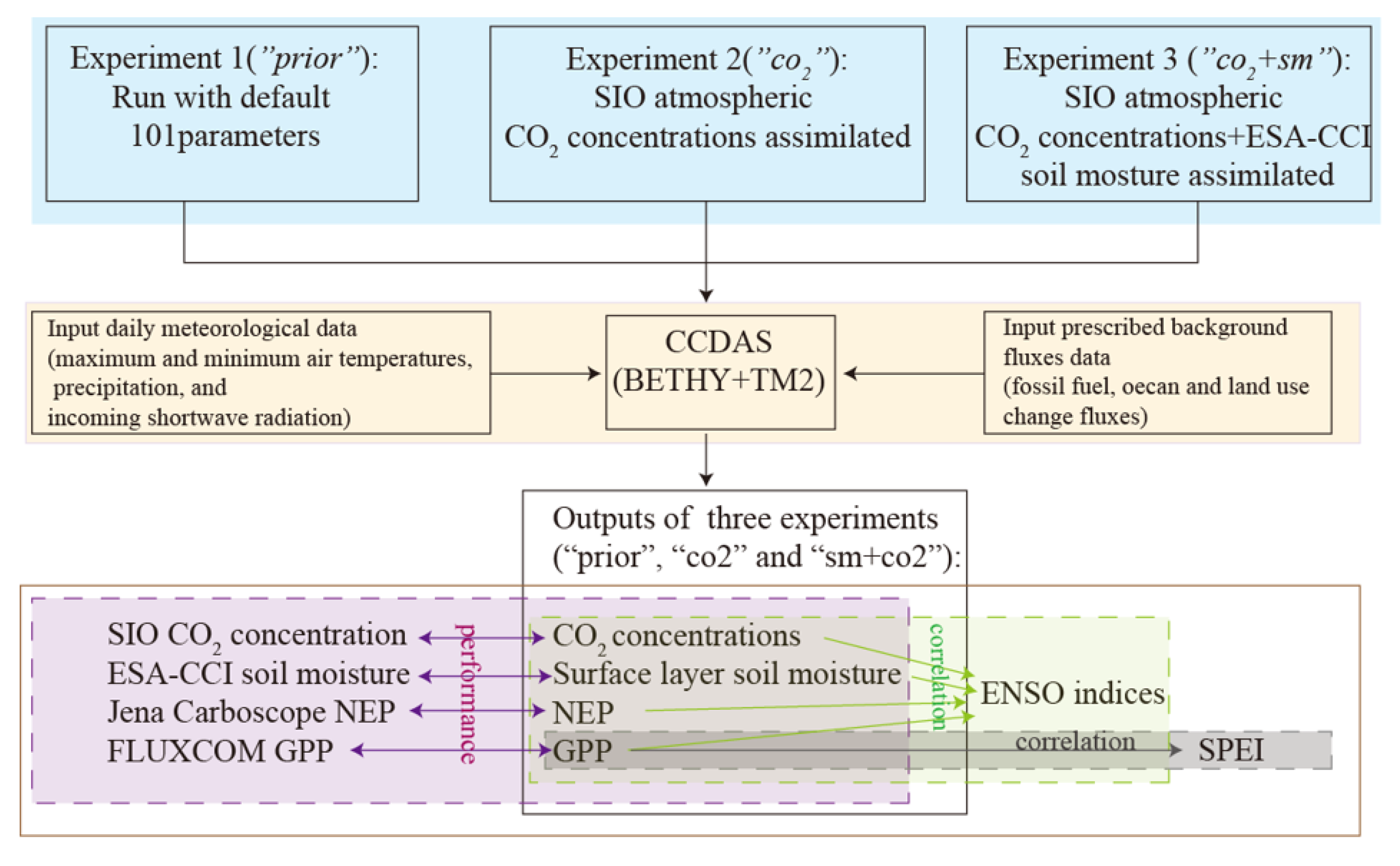
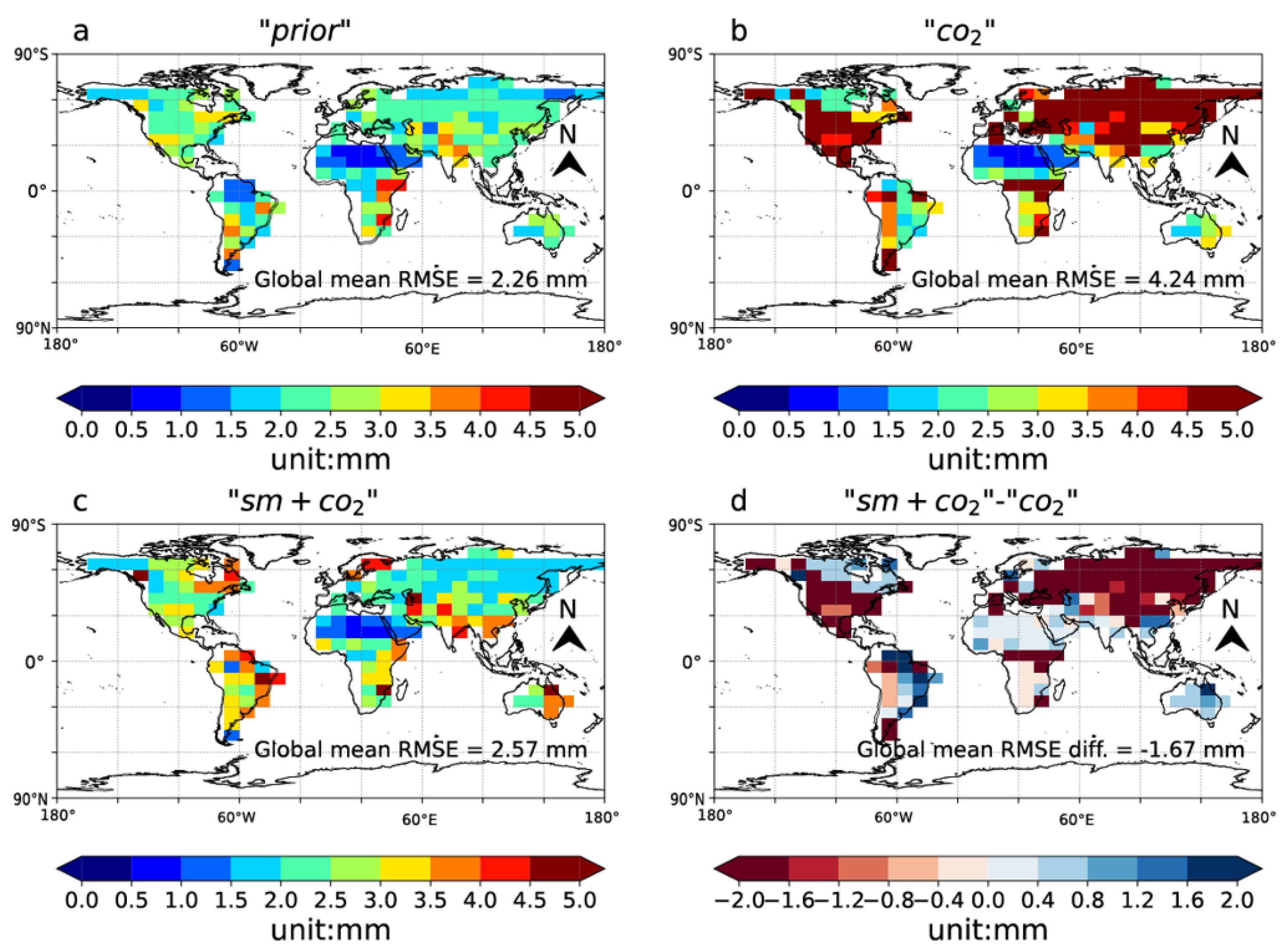
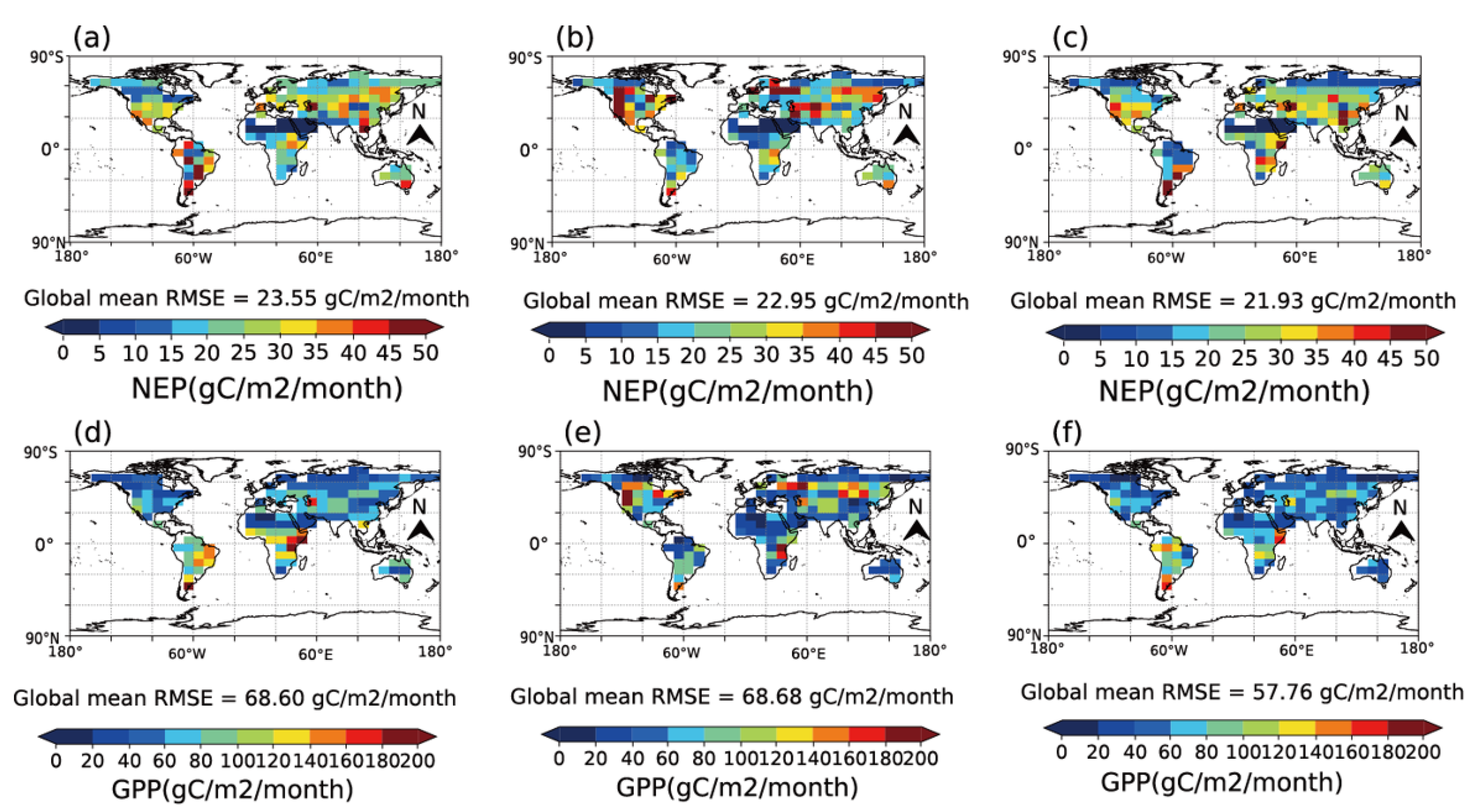
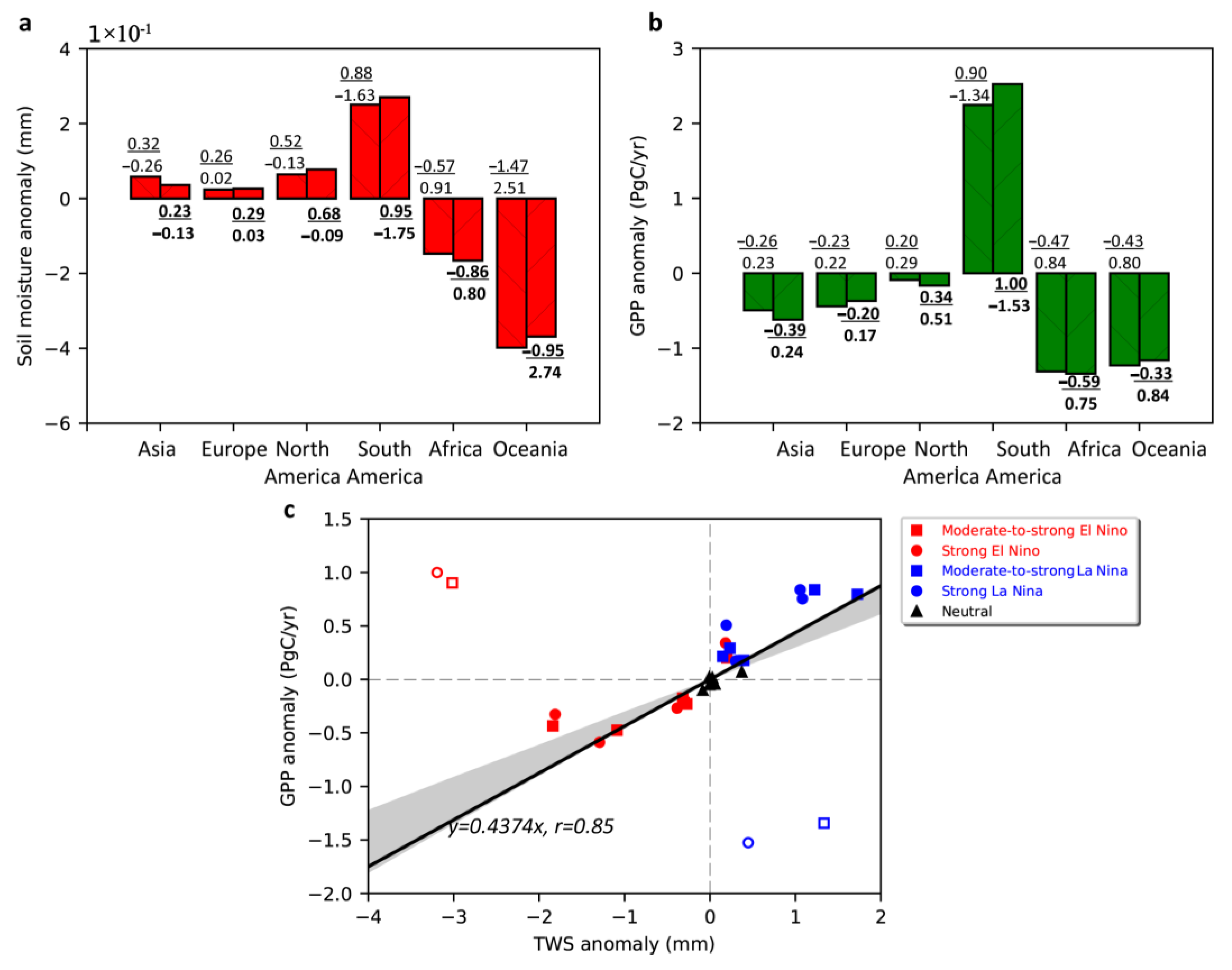
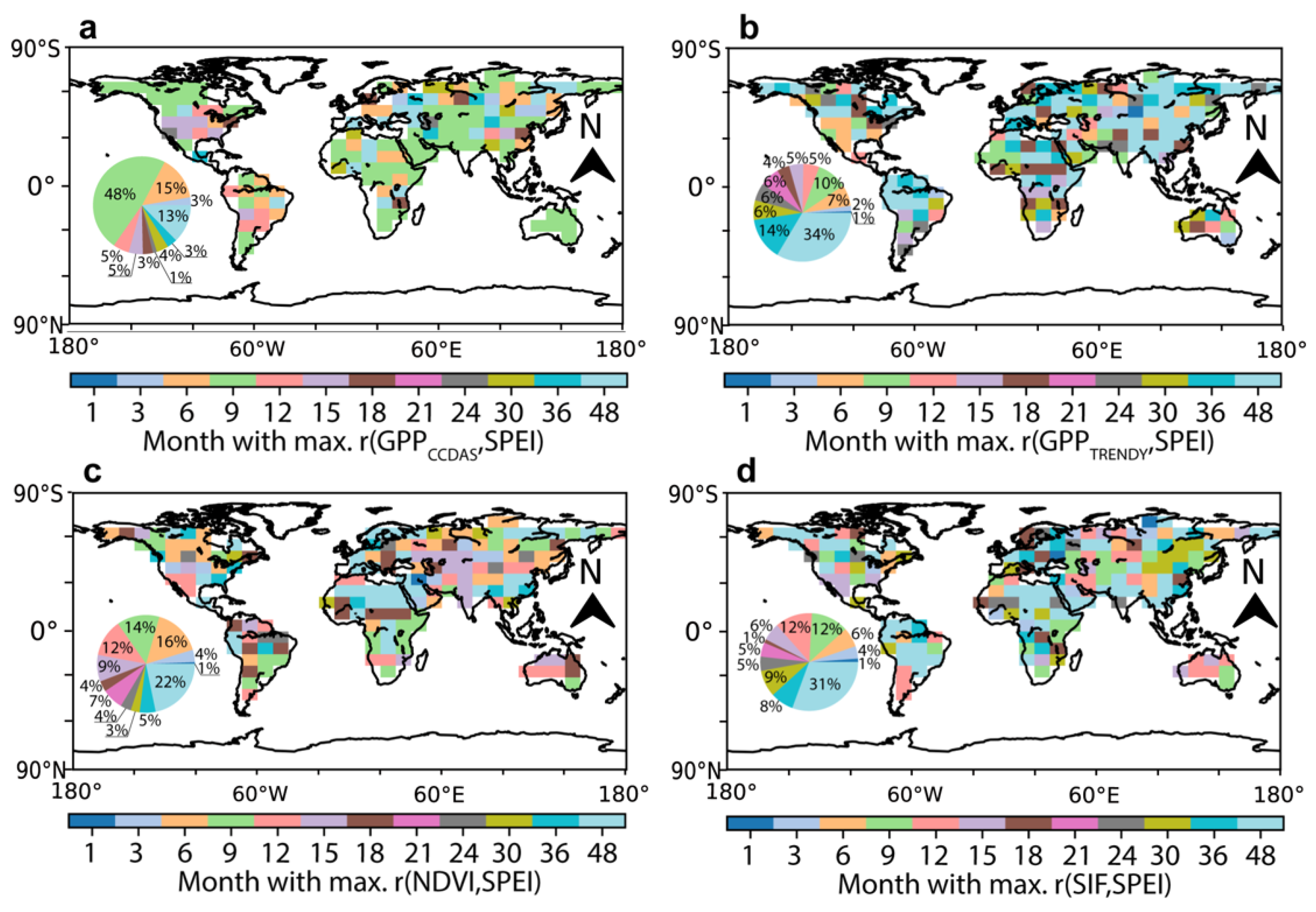
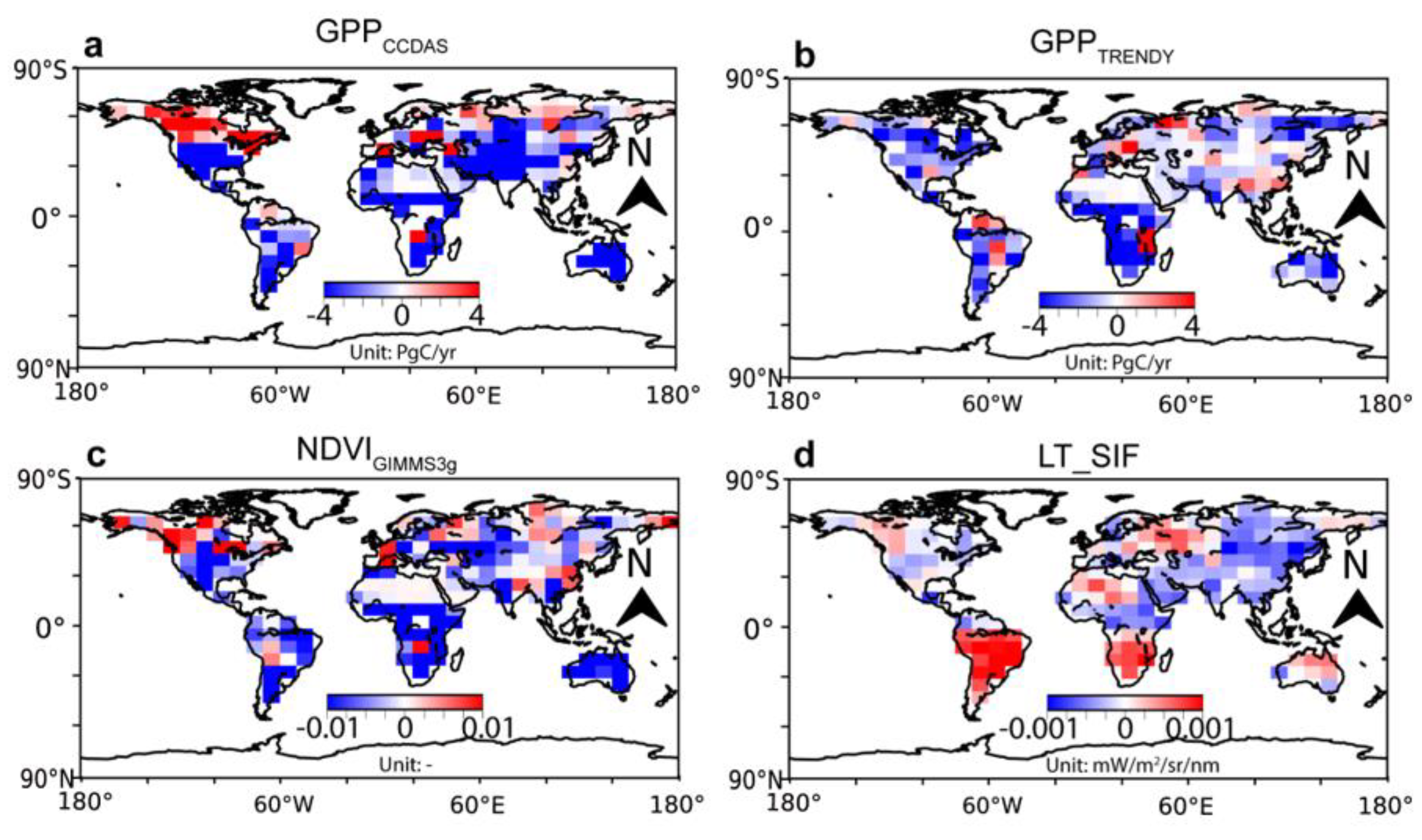

| Station Name | Location | “prior” | “co2” | “sm + co2” |
|---|---|---|---|---|
| ALT | 82.3°N, 62.3°W | 17.5 ppm | 1.54 ppm | 2.07 ppm |
| BHD | 41.4°S, 174.9°E | 15.56 ppm | 1.13 ppm | 0.89 ppm |
| BRW | 71.3°N, 156.6°W | 17.72 ppm | 1.71 ppm | 2.54 ppm |
| CHR | 2.0°N, 157.3°W | 15.9 ppm | 1.12 ppm | 1.12 ppm |
| KUM | 19.5°N, 154.8°W | 18.03 ppm | 1.28 ppm | 1.77 ppm |
| MLO | 19.5°N, 155.6°W | 17.76 ppm | 0.97 ppm | 1.42 ppm |
| SMO | 14.2°S, 170.6°W | 15.77 ppm | 0.89 ppm | 0.31 ppm |
| SPO | 90.0°S | 15.39 ppm | 0.80 ppm | 1.29 ppm |
Disclaimer/Publisher’s Note: The statements, opinions and data contained in all publications are solely those of the individual author(s) and contributor(s) and not of MDPI and/or the editor(s). MDPI and/or the editor(s) disclaim responsibility for any injury to people or property resulting from any ideas, methods, instructions or products referred to in the content. |
© 2023 by the authors. Licensee MDPI, Basel, Switzerland. This article is an open access article distributed under the terms and conditions of the Creative Commons Attribution (CC BY) license (https://creativecommons.org/licenses/by/4.0/).
Share and Cite
Xing, X.; Wu, M.; Scholze, M.; Kaminski, T.; Vossbeck, M.; Lu, Z.; Wang, S.; He, W.; Ju, W.; Jiang, F. Soil Moisture Assimilation Improves Terrestrial Biosphere Model GPP Responses to Sub-Annual Drought at Continental Scale. Remote Sens. 2023, 15, 676. https://doi.org/10.3390/rs15030676
Xing X, Wu M, Scholze M, Kaminski T, Vossbeck M, Lu Z, Wang S, He W, Ju W, Jiang F. Soil Moisture Assimilation Improves Terrestrial Biosphere Model GPP Responses to Sub-Annual Drought at Continental Scale. Remote Sensing. 2023; 15(3):676. https://doi.org/10.3390/rs15030676
Chicago/Turabian StyleXing, Xiuli, Mousong Wu, Marko Scholze, Thomas Kaminski, Michael Vossbeck, Zhengyao Lu, Songhan Wang, Wei He, Weimin Ju, and Fei Jiang. 2023. "Soil Moisture Assimilation Improves Terrestrial Biosphere Model GPP Responses to Sub-Annual Drought at Continental Scale" Remote Sensing 15, no. 3: 676. https://doi.org/10.3390/rs15030676
APA StyleXing, X., Wu, M., Scholze, M., Kaminski, T., Vossbeck, M., Lu, Z., Wang, S., He, W., Ju, W., & Jiang, F. (2023). Soil Moisture Assimilation Improves Terrestrial Biosphere Model GPP Responses to Sub-Annual Drought at Continental Scale. Remote Sensing, 15(3), 676. https://doi.org/10.3390/rs15030676






